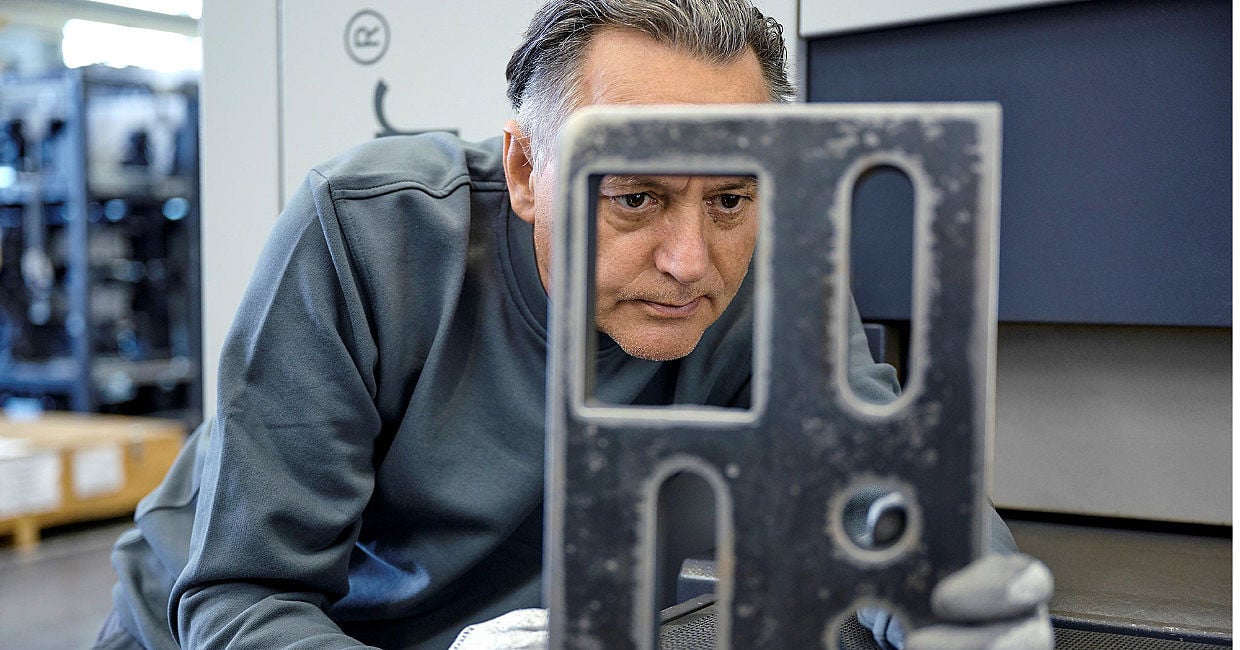1. Design specification: deburred and rounded edges
That's the way the client wants it: The design accompanying the order clearly demands burr-free edges. The exact radius for edge rounding is also specified. Instead of contemplating with the client, just feed the sheet metal parts into the deburring machine. With the machine you can meet both requirements.
And why is the client demanding this? You will have a better understanding when you look at the other situations.
2. Injuries and damages caused by burrs
Burrs are rough and sharp. Colleagues in fabrication and assembly, who handle the parts with burrs, can get injured. Not to mention the fact that the assembly process or even welding runs so much more smoothly without annoying burrs.
Safety gloves help but only so much depending on the size of the burrs. Today, nobody wants to be held accountable for injury risks, and that is why deburring has often become unavoidable.
Sharp metal edges pose hazards. Even though some parts are installed facing inward, an edge can cause a compressed air line or a cable to damaged.
Another specific example involved laboratory gloves, which should not get damaged when handling sharp sheet metal edges. Such risks that may occur can be ruled out by rounding the edges. This task can be mastered by the deburring machine as well.
3. Perils of product liability
The other nuisance of burrs: Burrs can break loose spontaneously at the most inconvenient time. This involves the danger that the final product gets damaged. In fact, burrs can easily impair safety functions. For manufacturers this means: They are liable for damages and must perhaps even initiate a product recall. Thus, making the costs much more than simply deburring.
4. Troubles during coating
Powder coating or cataphoretic dip coating, both make use of an electrostatic field. During paint separation, just like a lightning arrester, the sharp burrs lead to the concentration of the field lines on these sharp points. Uncontrolled separation of paint then occurs at these points.
Moreover, liquid coating materials, but also powder coatings, tend to not adhere to sharp edges. This means: While the paint cures, there is always the risk that it draws thin over a sharp edge or a burr. At those points the coating would not form a closed layer. The substrate material would be unprotected and exposed to the atmospheric oxygen as well as other impacts. Which in return leads to rust. Rounding edges is indispensable to eliminate sharp sheet metal edges.
5. Damage to galvanized sheet metal parts
Zinc coatings do not shrink on edges and sharp corners and thus these edges are galvanized at least as thick as the rest of the surface. Yet, zinc coating is much more affected by mechanical loads or impacts in the immediate area of the edge compared to smooth surfaces. Consequently: Galvanized components appear to be in order after the zinc bath or at the time of delivery to the construction site. But after assembly or a short time in use, faults appear on the metal edges. Under the microscope: Depending on the steel composition, the zinc layer structure of sharp edges is clearly faulty. Identical steel with only slightly rounded edges already shows a much more uniform layer. This is why, the standard DIN EN 1090 for steel structures requires that the edges of the sheet metal parts should be rounded with a radius of at least 2 mm. Corrosion protection has thus been ensured.
6. Damage to the tools
Burrs can cause damage to tools/machines during downstream processes. In particular, bending tools for forming, leveling rollers in roller levelers or turning tools and other precision tools used in metal cutting processes. The reason: Burrs are rough and can push into the bending tools or leveling rollers. Additionally, burrs can break loose spontaneously at any time and cause damage.
7. High tool wear
Tools are expensive. All the more annoying when they last a much shorter time than expected. In terms of bending tools: Even if burrs don't cause damage, they do increase wear. This can be counteracted via deburring.
Extra tip
You do not necessarily need to own a machine to deburr sheet metal and parts. You can contact a specialized company to do the job. Good providers are prepared for quick turnaround and understand immediately the requirements for sheet metal used in production. The necessary requirements associated efforts and the costs are prepared by the contractor. They also manage the logistics. However, damage during transport or additional contamination are excluded from the contract work.
